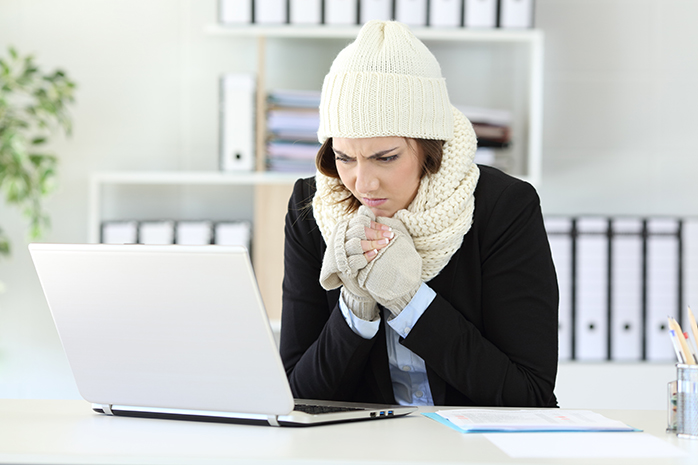
By Kristen Cifolelli, courtesy SBAM Approved Partner ASE
More often than not women complain about feeling cold at much higher rates than men, and there are several scientific reasons behind this fact. Women typically have a lower metabolic rate that results in being colder at rest.
Women’s blood vessels are located further from the skin surface than men and don’t warm the skin as efficiently. A woman’s body is also designed to keep the reproductive system warm, so heat tends to be kept in the woman’s body core.
For many women, working in an office environment can feel equivalent to working in a meat locker. Studies have shown that offices are set for men’s preferred temperatures. The formulas used to design and calibrate most heating and cooling systems are based on a single estimate of the metabolic activity of a 40-year-old, 155-pound male. This formula used to determine the body’s level of comfort was created in the 1960s and made no attempt to take women or people of different sizes or ages into account. This formula has not been updated in decades.
While working in a cold environment at a minimum is uncomfortable, a recent study published in the journal, PLOS ONE, found that women are less productive in a cold office and it may actually be hurting female employees’ performance. “It’s been documented that women like warmer indoor temperatures than men, but the idea until now has been that it’s a matter of personal preference,” Tom Chang, USC Marshall School of Business’ associate professor of finance and business economics and co-author of the study. “What we found is it’s not just whether you feel comfortable or not, but that your performance on things that matter — in math and verbal dimensions, and how hard you try — is affected by temperature.”
The study involved more than 500 college students taking a math, verbal, and cognitive reflection test at different times, while the room was set to temperatures between 61 and 91 degrees Fahrenheit. Overall while the groups’ test scores were relatively normal, differences were found between the male and female responses. When the room was warmer, women answered more questions on the math and verbal tests and got more questions right.
The women’s math and verbal test scores suffered when the room was set below 70 degrees. Women’s math scores; however, began increasing by 1.7% as the room got warmer. According to Agne Kajackaite, a behavioral economics researcher and co-author of the study, “If temperatures are cold, men are much better than women. When the temperature was below 70 degrees Fahrenheit, females solved, on average, 8.31 math tasks correctly. And when the temperature was above 80 Fahrenheit, females solved 10.56 tasks. That is, female performance increased by 27%.” In summary, the big takeaway was that the gender gap disappeared with each degree the room got warmer.
On the other hand, men performed better in cooler environments but their decrease in performance at warmer temperatures was not as great as women’s gains. According to the study, the difference in performance between the genders was “larger and more precisely estimated” among women than men.
As a result of their findings, Chang and co-author Agne Kajackaite suggest that, “Gender mixed workplaces may be able to increase productivity by setting the thermostat higher than current standards. People invest a lot in making sure their workers are comfortable and highly productive,” Chang added. “This study is saying, even if you care only about money or the performance of your workers, you may want to crank up the temperature in your office buildings.”